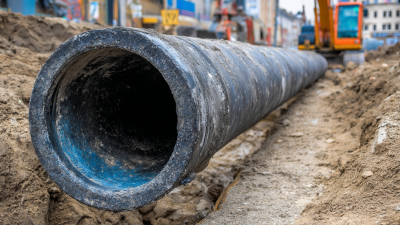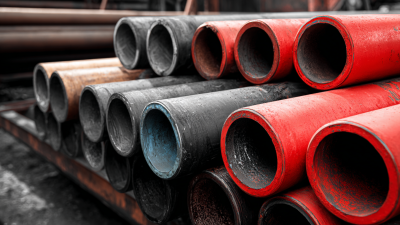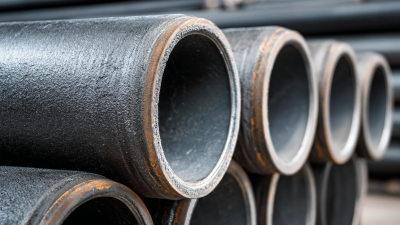Transforming Infrastructure: The Ultimate Guide to CIPP Pipe Repair Solutions
In recent years, the demand for efficient and sustainable infrastructure solutions has driven remarkable advancements in the field of pipeline repair, particularly through CIPP (Cured-in-Place Pipe) technologies. As reported by the American Society of Civil Engineers, the United States alone faces an estimated $3 trillion investment gap in infrastructure, underscoring the urgent need for innovative repair methods that minimize disruption and ensure longevity.

CIPP pipe repair solutions not only offer a cost-effective alternative to traditional excavation methods but also extend the lifespan of aging pipelines by an impressive 50 years, as highlighted in various industry studies. With the global trenchless technology market projected to exceed $8 billion by 2025, understanding and optimizing CIPP pipe repair strategies is essential for municipalities and contractors aiming to enhance operational efficiency while meeting environmental standards. This guide serves as a comprehensive resource for infrastructure professionals seeking to navigate the complexities of CIPP pipe repair in today's evolving landscape.
Understanding CIPP Rehabilitation: What You Need to Know
Cured-in-place pipe (CIPP) rehabilitation is an innovative solution that offers a cost-effective way to repair existing pipelines with minimal disruption. This method involves the insertion of a flexible liner coated with resin into the damaged pipe, which is then cured to form a rigid, durable new pipe. Understanding how CIPP works can help property owners and facility managers make informed decisions about their infrastructure maintenance.
Tips for successful CIPP rehabilitation include ensuring a thorough inspection of the existing pipe system before proceeding with repairs. Utilizing advanced techniques such as camera inspections can identify the specific areas in need of repair and prevent unnecessary work on intact sections. Additionally, it is crucial to choose a certified contractor experienced in CIPP methods to ensure high-quality results.
Another important tip is to consider the environmental impact of the materials used in the CIPP process. Opting for eco-friendly resins can not only reduce the ecological footprint but also improve the longevity of the repaired pipes. This proactive approach to pipeline rehabilitation not only safeguards your investment but also contributes to a more sustainable infrastructure network.

Choosing the Right Materials for Effective CIPP Repairs
When it comes to Cured-in-Place Pipe (CIPP) repairs, the choice of materials plays a crucial role in the effectiveness and longevity of the repair. Selecting the right resin is fundamental as it directly impacts the curing process and the overall integrity of the repaired pipe. Commonly used materials include polyester, epoxy, and vinyl ester resins. Each of these options has distinct properties: for instance, epoxy resins are known for their superior strength and resistance to chemicals, making them ideal for harsh environments. Polyester resins, on the other hand, offer quicker curing times, which can be beneficial in situations requiring rapid repairs.

Moreover, the lining material is just as critical as the resin. Fiberglass and felt linings are prevalent choices, each contributing different advantages. Fiberglass is favored for its rigidity and structural support, while felt lining provides flexibility and ease of installation, accommodating various pipe shapes and sizes. A thorough understanding of these materials and their applications ensures that decision-makers select the optimal combination for their specific repair needs, ultimately enhancing the efficiency and durability of CIPP projects.
Step-by-Step Process of Installing CIPP Pipes
CIPP (Cured in Place Pipe) technology offers a highly effective solution for repairing aging pipelines without the need for extensive digging and disruption. The step-by-step process of installing CIPP pipes begins with cleaning the existing pipeline to remove debris and blockages. This is crucial, as a clean surface allows for better adhesion of the new lining.
Next, a flexible liner is saturated with a resin mixture, which is then inserted into the prepared pipe. This liner is typically pulled into place or inverted using water or air pressure. Once positioned, the resin is cured, usually through steam or hot water, hardening to create a durable, jointless pipe within the old one.
**Tip 1:** Ensure that the pipeline environment is assessed thoroughly prior to installation. Identify potential leaks or structural issues that may affect the CIPP process.
**Tip 2:** Choose a reputable contractor experienced in CIPP installations. Their expertise can greatly influence the quality and longevity of the repair.
Finally, after the curing process, the new pipe is tested for integrity, ensuring it meets all operational standards. This method not only extends the life of the pipeline but also minimizes disruption to surrounding areas, making it an ideal choice for urban infrastructure improvements.
Common Challenges in CIPP Installations and How to Overcome Them
Cured-in-Place Pipe (CIPP) installations are becoming increasingly popular for their efficiency and minimal disruption to existing infrastructure. However, several challenges can arise during the process, including issues with access, weather conditions, and material compatibility. These obstacles can impede the installation timeline and lead to additional costs if not addressed properly.
To overcome these challenges, it's essential to conduct thorough pre-installation assessments. This includes evaluating the site conditions and identifying potential access issues beforehand. Planning for contingencies—such as extreme weather—can help ensure that installations proceed smoothly and safely. Adequate training for the installation team can also address issues related to material handling and application.
**Tips:** Always keep open communication lines with the project team and stakeholders. Regular updates can preemptively address any emerging issues. Additionally, investing in high-quality materials that are suited for the specific environmental conditions can significantly reduce the likelihood of complications during installation. Working closely with manufacturers to understand material specifications is crucial to ensure optimal performance and longevity of the CIPP solution.
Transforming Infrastructure: The Ultimate Guide to CIPP Pipe Repair Solutions - Common Challenges in CIPP Installations and How to Overcome Them
| Challenge | Description | Solution | Impact on Installation |
|---|---|---|---|
| Water Infiltration | Presence of water can compromise the resin curing process | Use of dewatering techniques before installation | Prevents incomplete curing and pipe failure |
| Structural Issues | Existing pipe conditions may not support the CIPP installation | Conduct thorough structural assessments prior to installation | Ensures adequacy of the host pipe |
| Temperature Fluctuations | Extreme temperatures can affect resin properties | Optimize installation conditions; monitor temperatures closely | Improves resin performance and curing time |
| Curing Time Delays | Unforeseen delays can prolong the project timeline | Implement a clear project schedule with contingency plans | Minimizes downtime and enhances project efficiency |
| Inaccurate Measurements | Incorrect diameter or length can lead to installation issues | Use advanced measurement technology for pipe assessment | Ensures precise fit and reduces material waste |
Maintenance Tips for Long-Lasting CIPP Pipe Solutions
CIPP (Cured-in-Place Pipe) repair solutions have revolutionized the way we maintain our infrastructure, offering a durable and efficient approach to rehabilitating aging pipes. However, to maximize the lifespan of CIPP installations, regular maintenance is crucial. By following a few simple tips, property owners can ensure their pipe systems remain in top condition for years to come.
One essential maintenance tip is to conduct regular inspections using advanced technologies such as video camera assessments. These inspections can help detect minor issues before they escalate into significant problems. Additionally, keeping tree roots and debris away from access points will prevent blockages that could compromise the integrity of the CIPP lining. Address any signs of wear or unusual behavior promptly to avoid costly repairs.
Another critical aspect is to monitor the flow within the pipes. It's advisable to maintain a consistent flow of water to prevent stagnation, which can lead to corrosion and other deterioration forms. Furthermore, implementing a routine cleaning schedule can help eliminate buildup and ensure that the pipes function effectively. By adhering to these maintenance strategies, you can extend the lifespan of your CIPP solutions and ensure reliable performance for your infrastructure.
Maintenance Tips for Long-Lasting CIPP Pipe Solutions
Related Posts
-

7 Essential Tips for Effective Sewer Pipe Sleeve Repair Techniques
-

7 Best Reasons to Choose CIPP Sewer Repair for Your Next Infrastructure Project
-

How to Choose the Right Sewer Pipe Sleeve for Your Plumbing Needs
-

Ultimate Guide to Effective Pipe Sleeve Repair Solutions for Global Procurement
-

How to Effectively Utilize Pipe in Pipe Repair Techniques for Long-lasting Solutions
-

Exploring the Future of Sewer Pipe Sleeve Innovations at the 138th Canton Fair 2025: Industry Trends and Market Growth

